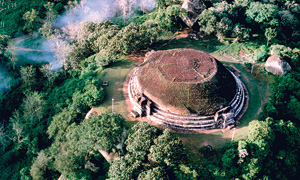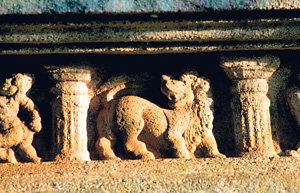Eight miles out of Anuradhapura, the rocky mountain of Mihintale rises abruptly out of the plain to a height of almost 1,000 feet. Here on the slopes of the mountain Apostle Mahinda encounters the king (Devanampiyatissa) as he was in pursuit of a stag. Standing on top of a great crag now known as the Aradhana Gala, the Rock of Invitation, the Apostle Mahinda told him the story of the Buddha and preached His doctrine. The conversion of the king and the whole country to Buddhism provides the foundation for our story. The kings of Lanka saw it as their duty to build for the glory of the faith ….
 |
| Kantaka Chaitya, Mihintale |
The Buddha's message unleashed the creative energies of the Sinhalese. Letters were engraved on stone, caves and then temples were hewn out of solid rock. Great dagabas were built in worship of the Buddha and His image was carved out of granite and marble. Huge monasteries arose many of them as large as towns, their buildings adorned with stone carvings of the most exquisite kind.
The reader is thus introduced to the dawn of a new civilization in Sri Lanka in the book 'Eloquence in Stone – the Lithic Saga of Sri Lanka'. Under the patronage of King Devanampiyatissa (250-210 B C), the royal capital Anuradhapura became the home of Theravada Buddhism. The king gave the lead in building stupas by erecting the Thuparama dagaba and a monastery for the monks. The location came to be known as Thuparamaya to indicate the presence of the dagaba and the 'aramaya'. According to the Mahavamsa, Thuparama had been built by the time the branch of the sacred Bo tree was brought to Sri Lanka. One of the eight saplings of the Bo-tree had been planted at the Thuparamaya.
Although the accent was on Anuradhapura, the objects of worship found in Mihintale bear testimony to the fact that there was lot of activity there too. The Kanthaka Chaitya, for example, is a fine piece of architecture and a symbol of the rich art of sculpture in ancient Sri Lanka. The four 'vahalkada' (frontispiece) are unique and are amongst the oldest sculptures in the country.
As described in 'Eloquence in Stone', the Kanthaka Chaitya marks the beginning of stone art in Sri Lanka. "Elephants kneel out of the stone, dragons spout forth and grotesque dwarves, wild and happy, throw their arms into the air. Serried ranks of dwarves and women line the panels, playing instruments and dancing in ecstasy. The whole 'vahalkada' was once plastered and painted in different colours. You can still see the outlines of lions in red and orange paint, their hues coming to life with the sun. Only then do you realise that what is now grey and faded stone, was once a mass of living colour. "
The four 'vahalkada' face the four cardinal points in the dagaba. There are four beasts – elephant, horse, lion and bull – facing each direction. The true to life figures are carved in the round from dolomite marble.
Intricate art can be seen at the Kanthaka Chaitya. The 'kalpa vruksha' (Tree of Life) is portrayed as a flowering plant rising from a vase of scrolls. On either side of the stem animals and yakkhinis stand back to back perching on its leaves. Seated at the very top is Kuvera, the God of Wealth, showering prosperity on the worshippers.
 |
| Sinha Pokuna Mihintale |
Another popular site is the Kaludiya Pokuna used as a private bathing place by the monks of Mihintale. "Built to capture the rainwater as it cascaded off the mountainside, here man used his skill to harness nature and beautify it. The pond is surrounded by great rocky boulders which litter the landscape. The steps, terraces, gardens and pavilions which adorn it have all been built around the rock following its shape and contours.
Steps curve up the rock to pavilions set on top of boulders. Terraces make their way over the open ground ascending higher and higher to platforms looking out over the pool, its waters black with the reflection of rocks and the shade of trees. It is the perfect example of man in complete harmony with his environment. Another culture would have cut through the rock and removed the boulder. Only we let it be." (Eloquence in Stone)
The Sinha Pokuna was once an open air bath which served the monks living in the caves around the Kanthaka Chaitya. Here too intricate sculpture can be seen particularly the figure of the great, man-sized lion which gave the fountain its name.
Amidst the lush greenery in the sacred area of Mihintale are ruins of many monasteries and other facilities provided for the benefit of monks.
|


